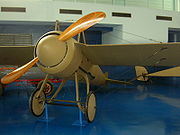
Spinner (aircraft)
Encyclopedia
A spinner is an aircraft component, a streamlined fairing fitted over a propeller
hub or at the centre of a turbofan engine. Spinners both make the aircraft over all more streamlined, reducing aerodynamic drag and also smooth the airflow so that it enters the air intakes more efficiently. Spinners also fulfill an aesthetic
role on some aircraft designs.
The spinner may be constructed from aluminium
or fibreglass. Often softer grades of aluminium are used to reduce the tendency to crack in service. Early fibreglass spinners introduced as kits for the homebuilt aircraft
market in the early 1990s initially developed a poor reputation for cracking. More recent models have resolved these problems and they now function as well as aluminium ones do.
The normal method of installation of a large spinner on a light aircraft involves installing a circular spinner back plate over the engine driveshaft, then the propeller, followed by a spinner front plate. The spinner dome is then mounted over this assembly and secured with screws to the back and front plates. Small plates are usually fitted behind the propeller to fill in the spinner dome cutouts and are secured to the backplate again with screws. Some spinner designs do not incorporate the front plate, although these are not suitable for higher powered engines.
The loss of a spinner in flight has caused damage to aircraft as well as accidents. If the spinner becomes partially detached then damage to the engine cowling can result, along with a high degree of vibration that results in the need for an immediate engine shut-down and a forced landing. In cases where the spinner has completely departed the aircraft it often impacts the airframe or the windshield, with potentially catastrophic results.
Because of their role as a rotating component and the risk of cracking and failure due to engine vibration, spinners require regular inspection, particularly of the back plate as well as the spinner dome itself.
 The first spinners were fitted to aircraft in the early 1910s to reduce drag caused by the large radial engines.
The first spinners were fitted to aircraft in the early 1910s to reduce drag caused by the large radial engines.
Propeller (aircraft)
Aircraft propellers or airscrews convert rotary motion from piston engines or turboprops to provide propulsive force. They may be fixed or variable pitch. Early aircraft propellers were carved by hand from solid or laminated wood with later propellers being constructed from metal...
hub or at the centre of a turbofan engine. Spinners both make the aircraft over all more streamlined, reducing aerodynamic drag and also smooth the airflow so that it enters the air intakes more efficiently. Spinners also fulfill an aesthetic
Beauty
Beauty is a characteristic of a person, animal, place, object, or idea that provides a perceptual experience of pleasure, meaning, or satisfaction. Beauty is studied as part of aesthetics, sociology, social psychology, and culture...
role on some aircraft designs.
Piston engine spinners
Piston-powered aircraft often have spinners of one of two basic designs. The large spinner fits over the propeller, while the smaller skull cap style is directly attached to the propeller and just covers the propeller mounting bolts.The spinner may be constructed from aluminium
Aluminium
Aluminium or aluminum is a silvery white member of the boron group of chemical elements. It has the symbol Al, and its atomic number is 13. It is not soluble in water under normal circumstances....
or fibreglass. Often softer grades of aluminium are used to reduce the tendency to crack in service. Early fibreglass spinners introduced as kits for the homebuilt aircraft
Homebuilt aircraft
Also known as amateur-built aircraft or kit planes, homebuilt aircraft are constructed by persons for whom this is not a professional activity. These aircraft may be constructed from "scratch," from plans, or from assembly kits.-Overview:...
market in the early 1990s initially developed a poor reputation for cracking. More recent models have resolved these problems and they now function as well as aluminium ones do.
The normal method of installation of a large spinner on a light aircraft involves installing a circular spinner back plate over the engine driveshaft, then the propeller, followed by a spinner front plate. The spinner dome is then mounted over this assembly and secured with screws to the back and front plates. Small plates are usually fitted behind the propeller to fill in the spinner dome cutouts and are secured to the backplate again with screws. Some spinner designs do not incorporate the front plate, although these are not suitable for higher powered engines.
The loss of a spinner in flight has caused damage to aircraft as well as accidents. If the spinner becomes partially detached then damage to the engine cowling can result, along with a high degree of vibration that results in the need for an immediate engine shut-down and a forced landing. In cases where the spinner has completely departed the aircraft it often impacts the airframe or the windshield, with potentially catastrophic results.
Because of their role as a rotating component and the risk of cracking and failure due to engine vibration, spinners require regular inspection, particularly of the back plate as well as the spinner dome itself.
History


